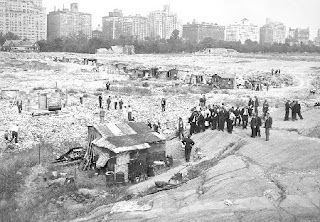43,000 marchers, including 17,000 World War I veterans marched on Washington DC and set up campgrounds demanding early payments of cash bonuses to help survive the Great Depression. Lovable old General Douglas MacArthur's Army advanced with bayonets and sabers drawn under a shower of bricks and rocks and in less than four hours cleared out the Bonus Army's campground using tear gas then burned down the camp grounds. The veterans had been promised bonuses, but they were not to be distributed until 1945. Congress was able to successfully award the Bonus Army their early cash bonuses in 1936.
 |
| A shanty town in New York's Central Park |
As governments usually do, they figured out ways to increase income. The Revenue Act raised United States tax rates across the board, with the rate on top incomes rising from 25 percent to 63 percent and the first federal gasoline tax applied at a rate of 1 cent per gallon. In an effort to stay afloat the Government and businesses implemented wage cuts up to 30 percent for those lucky enough to be employed. They also cut working hours for those employed hoping to provide more jobs for those who weren't.
The US government also forced hundreds of thousands of Mexicans out of the country during the recession years. Gangster Al Capone was convicted for income tax evasion, so he had a bad year, too.
Not everybody was suffering financially though; some celebrities, athletes, thieves and bottom feeders did quite well.
* Baseball star Babe Ruth raked in $80,000 a year which is over $1.4 million in today's dollars.
* Bank robber John Dillinger stole more than $3 million in today’s dollars
* Film star James Cagney was a top money earner in Hollywood. Other Hollywood stars managed to do quite well: Spencer Tracy, Bette Davis, Jean Harlow, Bing Crosby, John Wayne, Marlene Dietrich, Joan Crawford, Boris Karloff, Clarke Gable and Edward G. Robinson.
* Charles Darrow created the game Monopoly game and became the world’s first millionaire game-designer.
* Oil man J. Paul Getty was busy snatching up depressed oil stocks with his inheritance and created a new petroleum empire.
* Singing cowboy and movie star Gene Autry was making millions
* Joe Kennedy Sr., the patriarch of the Kennedy family, made lots of money in various ways: stock speculation, real-estate, liquor and movies.
Towards the end of the year in November voters overwhelmingly kicked President Herbert Hoover out of office in favor of Franklin D. Roosevelt.
In 1932 the major tournaments were: Hastings-won by Salo Flohr Pasadena-won by Alekhine Mexico City-Alekhine and Kashdan shared first Bad Sliac-Salo Flohr and Milan Vidmar shared first.
According to Chessmetrics the strongest tournament for the years 1932 and 1933 was Bern, 1932. This tournament included five of the top ten players in the world. The next-strongest tournaments were London, 1932 and Bad Sliac, 1932.
The Berne tournament also served as the Swiss Championship as ten Swiss players competed for the country's 36th Championship. The time limit was 40 moves in two and a half hours and for the second session, 25 moves in one and a half hours. There were no rest days or extra days for adjourned games.
 |
| Bernstein |
1) Alekhine 12.05
2) Euwe and Flohr 11.5
4) Sultan Khan 11.0
5-6) Bogoljubow and Bernstein 10.0
7-8) Hans Johner and Paul Johner 7.0
9-12) Henneberger, Naegeli, Rivier and Grob 6.0
13) Colin 5.5
14) Voellmy 4.5
15) Gygli 3.5
16) Staehelin 2.0
 |
| Henneberger |
 |
| Paul Johner |
There were a lot of brilliant games played in Berne, but the following is probably best described as “cute” when Alekhine defeated Dr. Adolf Staehelin (1901-1965) in a miniature. Staehelin was born in Basel, was Swiss champion in 1927 and passed away in Zurich in 1965.
 |
| Hans Johner |
This is one of those typical Alekhine games where he gains the advantage almost effortlessly and concludes with a bang. It's an example of Spielmann's statement that he could see combinations as well as Alekhine, but lacked the ability to get the positions with the ease that Alekhine did.


No comments:
Post a Comment